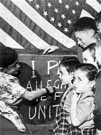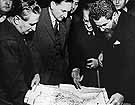
|
|
|

|

|

|

|
|
Click on an image to see a larger, more detailed picture.
|
|
|
|
|
| EPILOGUE: The Aftermath |

|
pg. 662 |

|
|
|
|
| |
 Immigration to the United States gave many Jewish child survivors of the Holocaust fresh starts, but nothing could compensate for their losses.
Immigration to the United States gave many Jewish child survivors of the Holocaust fresh starts, but nothing could compensate for their losses.
Photo: Hebrew Immigrant Aid Society / United States Holocaust Memorial Museum Photo Archive
|
 Jewish leaders (left to right) Nahum Goldmann, David Horowitz, Emanuel Neumann, and Rabbi Wolf Gold examine a map on November 12, 1947. It shows the United Nations' proposal for Palestine's partition.
Jewish leaders (left to right) Nahum Goldmann, David Horowitz, Emanuel Neumann, and Rabbi Wolf Gold examine a map on November 12, 1947. It shows the United Nations' proposal for Palestine's partition.
Photo: Central Zionist Archives / United States Holocaust Memorial Museum Photo Archive
|
 On November 29, 1947, the UN approved a plan for the partition of Palestine, which included provisions for the creation of a Jewish state. Members of Yishuv (the Jewish community of Palestine) celebrate the news.
On November 29, 1947, the UN approved a plan for the partition of Palestine, which included provisions for the creation of a Jewish state. Members of Yishuv (the Jewish community of Palestine) celebrate the news.
Photo: Gov't. Press Office, Lishkat-Ha-ltonut / United States Holocaust Memorial Museum Photo Archive
|
|
Many survivors continue to feel that sense of estrangement from the world, and to find it difficult, if not impossible, to celebrate anything resembling a human "triumph" over the Holocaust's destructiveness. Yet that same estrangement may be able to evoke responses at the deepest levels of human concern. As Lawrence Langer reminds us, there is profound horror in "a baby torn in two or a woman buried alive." Still, if we develop and maintain a deeply grounded awareness of the Holocaust, we may yet prevent despair and death from having the last word. The state of Israel illustrates that possibility. Destiny and Struggle Spring 1945. Hitler was dead, the Third Reich in ruins. Many non-Jews across the globe assumed the horror had ended, but that was true only to a degree. The state-orchestrated terror and extermination had been forced to a halt, but antisemitism still was rife throughout continental Europe. Former SS and other low-level perpetrators roamed about freely, and the whereabouts of some top-level or high-profile Nazis were unknown. There seemed to be little sympathy in Great Britain and the Americas for Jewish concerns. Jews had no illusions about their lot. Murderous antisemitic pogroms in Poland in 1946 only drove home the truth: If Jews were to live in security, they would have to make their own way--forge their own nation. For Jews at the end of World War II and immediately thereafter, the goal for tens of thousands of Holocaust survivors was emigration to Palestine, where they hoped to join the Jews of Palestine in building an independent Jewish homeland. The British, however, still controlled Jewish immigration. Fearing that a flood of Jewish refugees would alienate the Arab world, the British remained unwilling to permit large-scale Jewish entry. They permitted a meager legal quota of 1500 Jews per month and clamped down on "illegal" immigration. Nevertheless, between 1944 and 1948, more than 200,000 Jews tried to flee to Palestine, crossing borders any way they could.
|
|

|

|

|

|
 May 15, 1948: Egyptian and Jordanian forces invade the one-day-old state of Israel; See January 7, 1949.
May 15, 1948: Egyptian and Jordanian forces invade the one-day-old state of Israel; See January 7, 1949.
|
 June 2, 1948: Viktor Brack, former SS-Oberführer and organizer of "euthanasia" Aktion T-4, is hanged at Germany's Landsberg Prison after being convicted of war crimes. Karl Brandt, Adolf Hitler's physician and SS-Gruppenführer, involved in illegal medical experiments, also is hanged at Landsberg Prison after being convicted of war crimes.
June 2, 1948: Viktor Brack, former SS-Oberführer and organizer of "euthanasia" Aktion T-4, is hanged at Germany's Landsberg Prison after being convicted of war crimes. Karl Brandt, Adolf Hitler's physician and SS-Gruppenführer, involved in illegal medical experiments, also is hanged at Landsberg Prison after being convicted of war crimes.
|
 September 30, 1948: The United Nations Relief and Rehabilitation Agency closes.
September 30, 1948: The United Nations Relief and Rehabilitation Agency closes.
|
 November 1948: During a purge of Soviet-Jewish culture, Soviet leader Joseph Stalin suspends publication of the Yiddish-language journal Eynikeyt (Unity).
November 1948: During a purge of Soviet-Jewish culture, Soviet leader Joseph Stalin suspends publication of the Yiddish-language journal Eynikeyt (Unity).
|
|
|
|
|
| EPILOGUE: The Aftermath |

|
pg. 662 |

|
|
The Holocaust Chronicle
© 2009 Publications International, Ltd.
|
|
